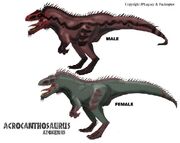
Illustration by packraptor of JPLegacy
Isla Sorna[]
Length: 44 Feet (Male), 43 Feet (Female)
Height: 17 Feet (Male), 16 Feet (Female)
Weight: 7.8 Tons (Male), 6.3 Tons (Female)
Coloration:
- Male: A rusty, reddish brown, maroon head, and darker red markings along its body.
- Female: A dull grayish green, reddish markings lighter than those of the male.
- Juvenile: Uniform color a pale brown.
Diet: Medium to large sized herbivorous dinosaurs. Acrocanthosaurus is capable of hunting and bringing down smaller sauropods single handedly. Acrocanthosaurus will also chase away smaller predators from their kills and will readily consume rotting carcasses.
Preferred Habitat: Prefers areas where the ground is firm and stable, as its feet can sink easily into waterlogged mud. It tends to avoid jungle and dense woodlands.
Social Structure: Solitary.
Acrocanthosaurus is one of the largest big-game hunters on Isla Sorna, second to Tyrannosaurus. Both Acrocanthosaurus and Tyrannosaurus are very evenly matched in combat, so they do try to avoid each other as much as possible. However, confrontations do sometimes occur, often accidentally, and the fights between the two, although rare, are very brutal.
Acrocanthosaurus is related to the slightly smaller Allosaurus, although it possesses a far superior strength thanks a burlier build and its iconic back-ridge, supported by extended vertebrae. The hump is an attachment for muscles and helps to reinforce its skeleton, giving the dinosaur great strength for its size. As a result Acrocanthosaurus is quite capable of bringing down very large animals such as adult hadrosaurs and young sauropods by itself. Unfortunately this additional bulk also renders Acrocanthosaurus as slower-moving, falling in between Allosaurus and Tyrannosaurus in terms of speed, and it lacks endurance for running. Therefore instead of actively chasing after prey Acrocanthosaurus tends to ambush or target weaker, slower moving prey, as well as scavenging carrion whenever the opportunity arises.
Acrocanthosaurus' forelimbs are long and well-muscled, with grasping three-fingered hands tipped with eagle-like talons, used for maiming prey. The teeth small and serrated, perfect for slicing soft meat but not for crushing bone like the tyrannosaur. Acrocathosaurus attacks in a manner similar to Allosaurus – by running at the victim and inflicting deep wounds with its jaws and the scythe-like talons on its hands before backing away and repeating the process until its victim succumbs to bloodloss.
Both males and females are territorial and aggressive towards one another and other theropods. When a receptive female calls out for a male with which to breed, competition between males become even more fierce and fights will often break out, sometimes to the death. A female will choose a suitor based on the vibrancy of his coloration, his strength, assertiveness, and his ability to fend off his rivals. Sometimes she may provoke him to fight with her prior to mating, to test his skills. The pair will remain together for a few days until they go their separate ways. After the male returns to his territory, the female will construct a mound of earth to serve as her nest and when the young hatch, she will protect them until they come of age, chasing them away when they reach adolescence. Siblings may remain together for a short while longer before dispersing.
An unusual characteristic of this predator is the tall, slender keratin spikes which sprout along its back and tail, as well as the top of its head, chin and throat. The purpose for these spikes is uncertain.